🎮 The FriendMatch: https://carinaly.itch.io/friendmatch
P2 Iterations: https://carinaly.itch.io/
🔗 P2 Deliverable Documentation
Premise & Overview
As the reader, you will be playing as a high school senior who just transferred schools a month ago. You are having trouble making friends and fitting into the new environment. One day, you hear about FriendMatch, an app that helps people find and match friendships based on people’s profiles. You match with Alex, who is seemingly the perfect friend and love interest for you. Or are they? As you text Alex, you begin to bond over similar interests until Alex ignores you and suddenly asks for an absurd amount of money. It is up to the user to make wise decisions and prevent themselves from being bamboozled by Alex.
This story goes through a student’s experience of transition and self-discovery when they are trying to figure out who they are and how to fit in. This phase can make kids vulnerable and easy targets for scams and similar schemes. The objective of the story is to raise awareness about the signs of catfishing and its potential effects. I want to show players how nuanced the catfishing process can be and how to keep an eye out for these signs to protect their mental well-being. While I have seen quite a few articles about catfishing, I felt that the media portrays these cases to be so humorous and outrageous that people find it hard to believe that it could happen to them. However, after reading that there are more than 20,000 reported catfishing cases per year, it made me realize that this was a significant issue and there are not enough compelling resources about the topic.
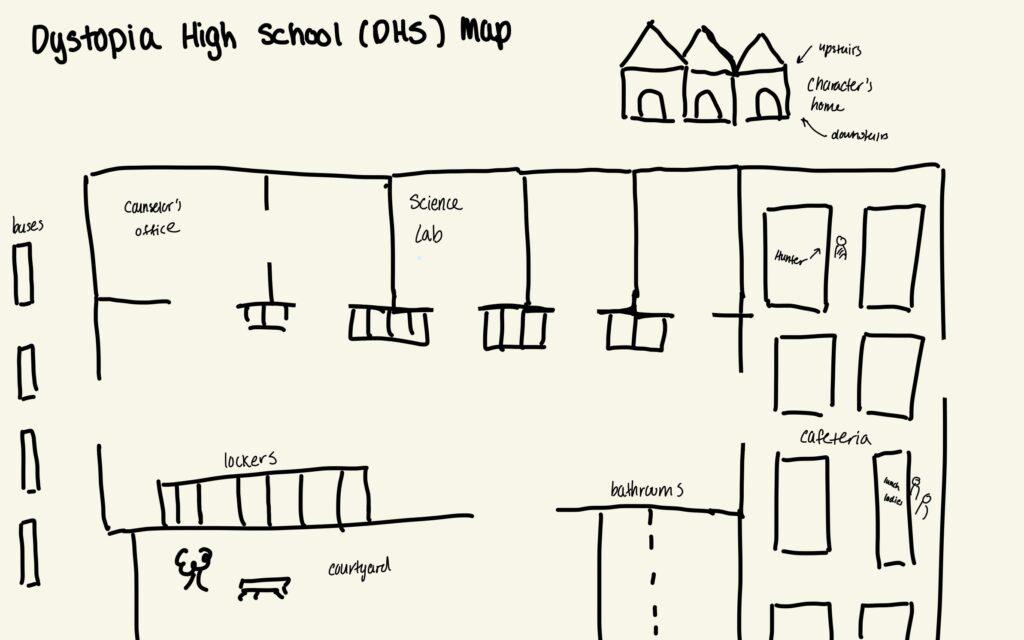
Iteration #1
Iteration #1 Link: https://carinaly.itch.io/p2-iteration-1
Initially, this story was going to be about the effects of physical bullying and cyberbullying. This prototype had the premise of a high school senior who tries to fit in and runs into all sorts of drama and bullying situations. It is up to the reader to navigate this environment and find the right friend group for her. I was interested in this topic because I was bullied during this time–it was extremely difficult for me because I was trying to understand myself while juggling academics, personal issues, and difficult social life. However, these experiences allowed me to grow personally and develop new skills that I have applied to other situations in my life, which have led me to form long-lasting relationships. Therefore, I was hoping that my story would be able to accomplish this goal.
I intentionally added a lot of imagery to set the tone and setting for the high school, as I felt that the surroundings mattered to create a clear picture of what the character is going through. When I was ideating, I also played a lot of Episode Interactive, which is a storytelling app that has stories that vary based on the players’ decisions. Many of these stories took place in a high school so I drew a lot of inspiration from the platform.
My first iteration of the story was very short, as I spent most of my time learning how to use Twine and mentally mapping the high school through imagery. I also reflected on how to implement the decision-making aspect into the story. I wanted to know if I wanted to explicitly as users what they would do or subtly highlight phrases throughout the story that indicated conflicting thoughts so users could select the thought they resonated with more.
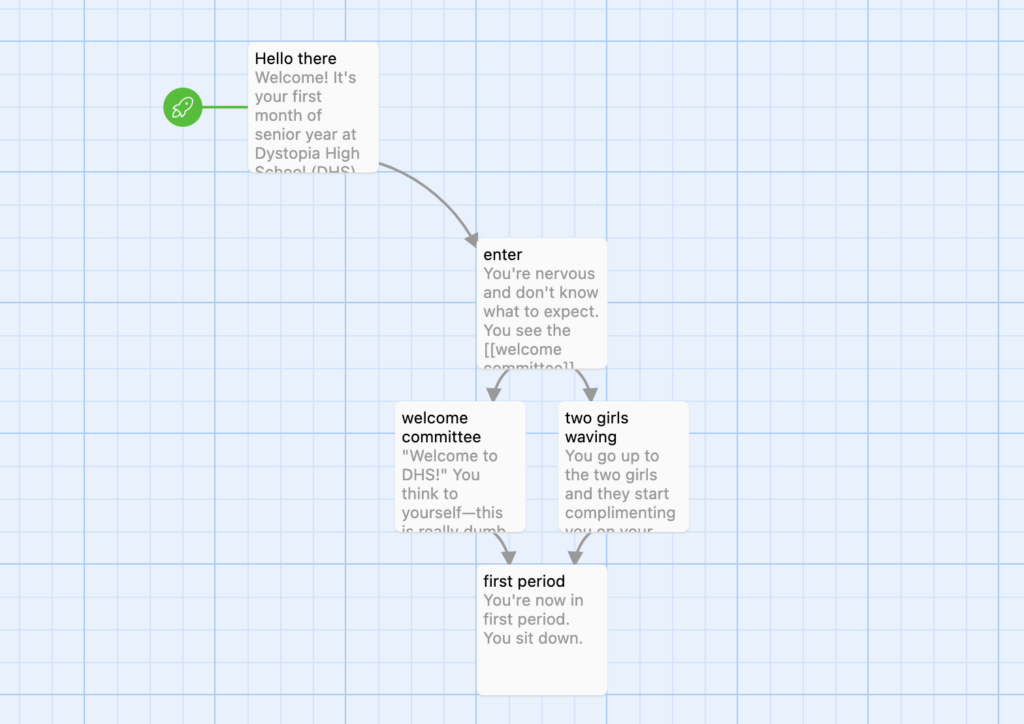
Iteration #1 Feedback
After the first playtest in class, I was challenged to think about a more novel topic beyond bullying. The playtester believed that there were plenty of online resources and books that covered bullying and she felt like the setting could teach something more unique than bullying. She enjoyed the imagery and the decision-making aspect of “navigating around the school” and choosing what to do. But she mentioned to me that she did not see how my story could teach users about bullying and felt that it would take too long to develop the character. Lastly, she wished that the story dove deeper into the characters’ inner thoughts.
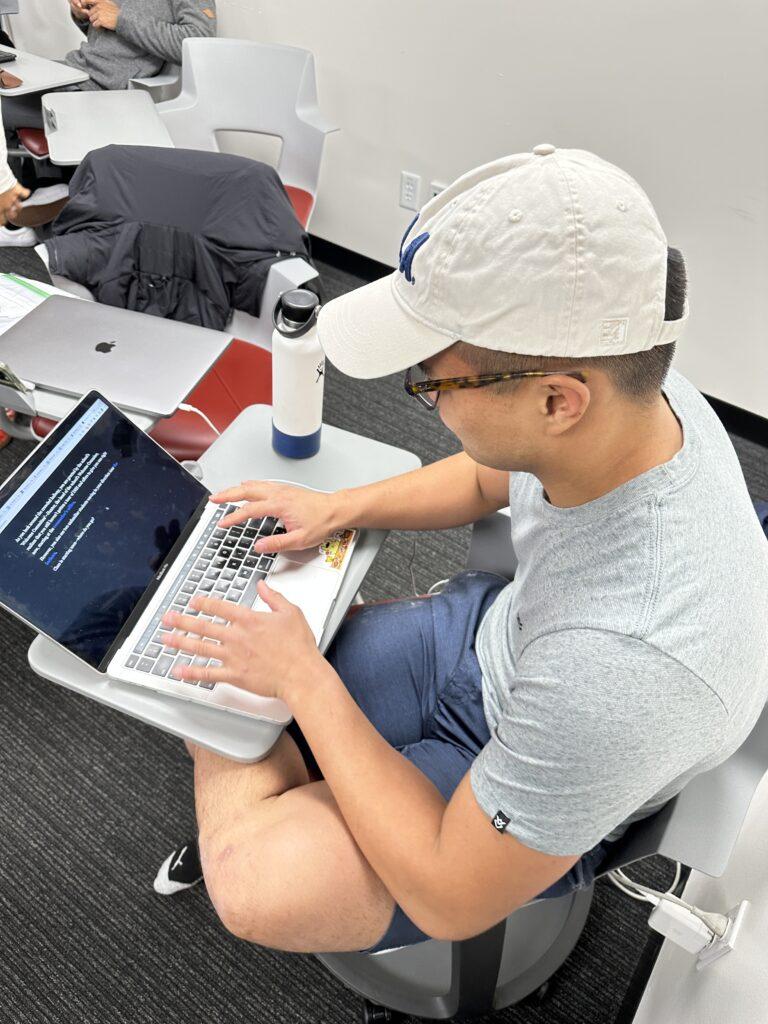
Iteration #2
Iteration #2 Link: https://carinaly.itch.io/p2-iteration-2
To address her comments, I decided to do research on bullying. After seeing so many activities and games about this topic, I wanted to branch out and create something new that did not garner that much attention in the media, which is why I started looking for more intriguing topics, such as catfishing.
For the second iteration of my story, I pivoted to have users go through a catfishing scheme and came up with the premise and overview that are described above. The story has five “escape points,” as users can “beat the catfisher” if they can notice the different catfishing signs throughout the story. This iteration has over 70 passages on Twine and readers will always be able to loop back to the two outcomes: being catfished or not. I decided to use the medium and font to shift between the second-person and third-person perspectives. The italicized font represents the character’s internal thoughts and texts that are read off the phone while the normal font is written in the third person and moves the story along.
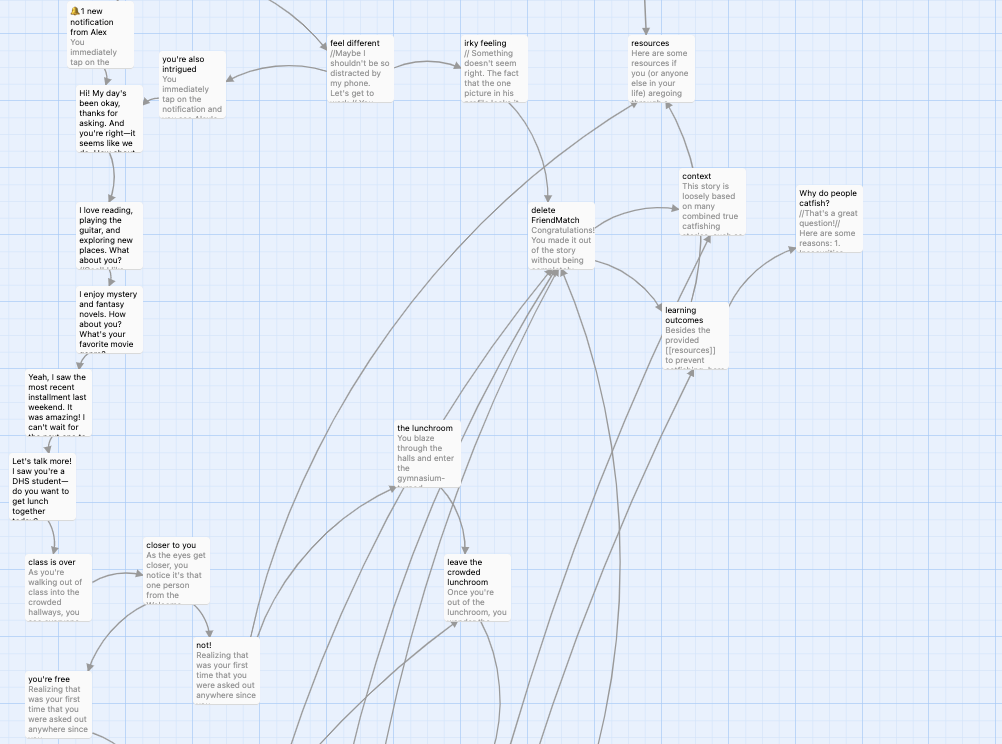
To test out these changes and check the relevancy of the topic, I asynchronously showed this version to the teaching team, ran an in-class playtest, and ran an in-person playtest with a stranger. I asked some questions to the in-person playtesters before the game:
Pre-Playtest Questions
- How would you rate your social life in high school?
- Playtester #2: “I’d say I was orienting myself around academics so I wasn’t very aware of the social life at my school.”
- Playtester #3: “I was pretty social—I made friends through orchestra and classes.”
- Did you have a friend group?
- Playtester #2: “Yes, I had a 6-person friend. I feel like 4-6 people is best and different and outgoing.”
- Playtester #3: “Yes, I had friends from my classes.”
- Did you ever feel alone or lonely in high school?
- Playtester #2: “I had this feeling in freshman year and the beginning of my sophomore year because I went to a different middle school. Coming to a different school with new people where people had established friend groups was tough. Also, I was the only Asian guy in my grade and felt left out sometimes.”
- Playtester #3: “Not really, I’ve been with the same friend group since middle school. But I do know lots of people who felt lonely and have had to readjust.”
Iteration #2 Feedback
After these playtests, I gathered feedback about their thoughts on this updated game concept. To note, because Playtester #2 and #3 had similar and minor comments, I did not publish a completely new iteration of the game and made edits on the same file as they gave their feedback.
The playtesters understood the purpose of the game and felt that catfishing was important for readers to learn about. In fact, one of the playtesters said it was very reminiscent of his friend’s experience, who was catfished on Kik, an anonymous messaging app. Having witnessed that event, he felt that my story did a good job of encapsulating it. He was messaging a girl, who turned out to be non-existent, and was eventually catfished. Thinking from his friend’s perspective, this playtester suggested that there could be more resources for victims and ways to handle it emotionally. Additionally, he liked the transition between reading the texts and hearing the character’s internal thoughts, confirming that people would understand my font choices throughout the story. The second playtester, who was not a CS 377G student, had similar praise—he had no context about catfishing and learned a “significant amount” about the topic. However, he was confused about why the catfisher would voluntarily meet with the victim after receiving the money.
Interestingly, all playtesters mentioned the randomness of the character being pushed into lockers. While they understood my intentions of establishing the setting, it did not tie into the catfishing scheme and suggested that it be replaced with a more subtle situation. They also did not find it realistic for Mr. Jones, the school’s science teacher, to scam a high schooler for money.
Implementing Feedback & Final Iteration
To address this feedback and make the story more realistic, I added even more links that specifically listed ways for catfishing victims to cope with the situation if readers were ever in a similar situation.
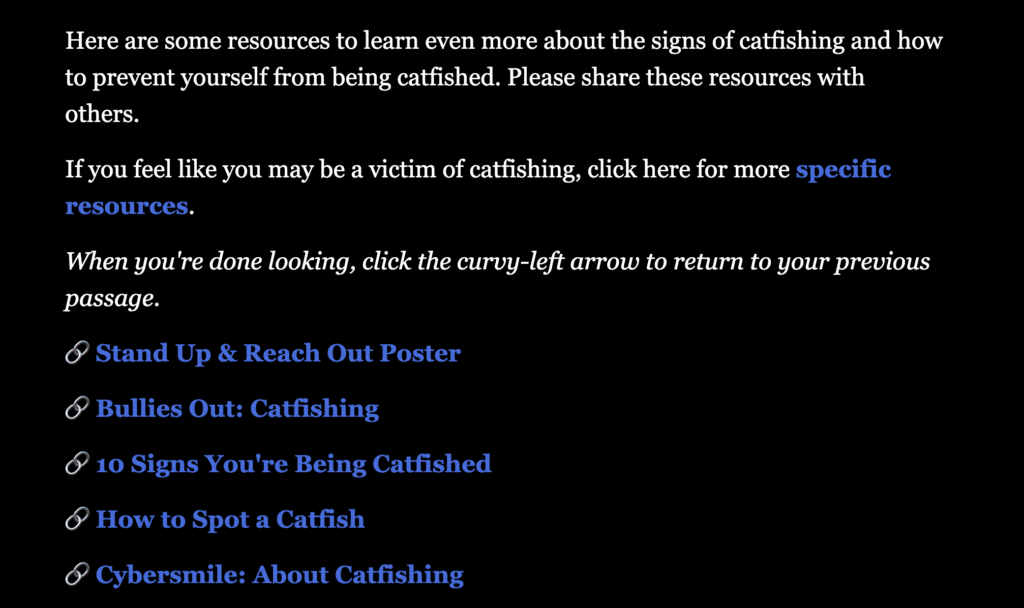
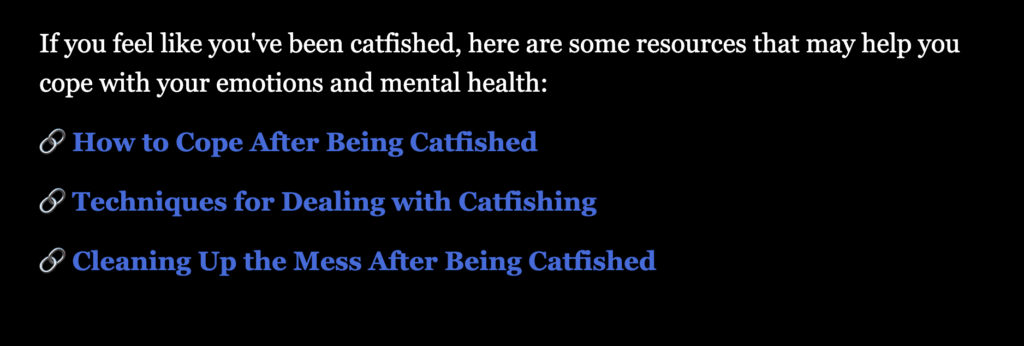
I also added an aftermath that revealed who the catfish was. I chose the catfisher persona to be based on an actual catfisher from a recent news story. This would provide more relevancy to my story and would make more sense, given the context of my story and my playtesters’ feedback. Finally, to better establish the story setting and make the negative social experiences more relatable, I implemented sound effects on most pages, decided to introduce verbal bullying (specifically a microaggression), and remove the locker scene, as the character was pushed to the ground for no legit reason, which is unrealistic.
Final Link: https://carinaly.itch.io/friendmatch
Reflection
In this project, I was able to ideate and create an interactive fiction game that guides a player through a high schooler’s experience of being catfished. The story-driven play immerses users in the character’s feelings, especially since they have control over the character’s decisions throughout the game. I learned how to use Twine to build an interactive fiction story with audio effects, in which the player can immerse themselves in the game with their imagination and make decisions that affect the consequences of the story’s direction and outcomes. More specifically, I learned how to create an interactive game that has both an educational and fun aspect to it, which helps users stay engaged while learning something new. If I were to do this project again, I would want to add even more player choices and branches to the story, as increasing the number of branching paths in the story can add more depth and make the game feel more interactive. In this project, I brainstormed by myself and chose a topic that only I felt would be educational. Next time, I would want to conduct more initial research to discover new ideas that the audience members care about and playtest on a more diverse group of users to further improve my game.
*Edited to include entire P2 reflection (see here for submission for initial “P2 Reflection Assignment”)
In this project, I ideated and built an interactive fiction game that raises awareness about the signs of catfishing. I centered this game around a high school student who just transferred and is having trouble adjusting to their new environment. The experience around the character makes them vulnerable to catfishing—players will be able to feel the emotions throughout the game. However, players have control over how to handle and prevent these kinds of emotions.
The story-driven play immerses users in the character’s feelings, especially since they have control over the character’s decisions throughout the game. I added a lot of imagery to set the tone and setting for the high school, as I felt that the surroundings mattered to create a clear picture of what the character is going through. I also took advantage of Twine’s medium to make this story truly interactive by having multiple decision points that branch out to new storylines and affect the overall outcome of the game and the consequences of the game. To further educate the audience, I implemented external resources that allow players to look into more if they were interested in being aware of catfishing.
I learned how to use Twine to build an interactive fiction story with audio effects, in which the player can immerse themselves in the game with their imagination and make decisions that affect the consequences of the story’s direction and outcomes. More specifically, I learned how to create an interactive game that has both an educational and fun aspect to it, which helps users stay engaged while learning something new. This project allowed me to hone my creative writing and storytelling skills. Through each playtest, I learned how to iterate on my characters and plot to make my story even more engaging. Before this project, I had never written any branching fictional stories. It was a steep learning curve to tie the story together, as the story could be infinitely long because of the limitless branching possibilities that Twine allows. Most importantly, I learned about the importance of catfishing. While there are quite a few articles about the topic out there, I felt that the media portrayed these cases as so humorous and outrageous that people feel like it could not happen to them. However, after learning about the subtle signs that lead to people being catfished and reading about how there are more than 20,000 reported catfishing cases per year, it made me realize that this was a significant issue and there are not enough engaging resources about the topic.
If I were to do this project again, I would want to add even more player choices and branches to the story, as increasing the number of branching paths in the story can add more depth and make the game feel more interactive. In this project, I brainstormed these ideas by myself and chose a topic based on what I felt would be educational. Next time, I would want to conduct more initial research to discover new ideas that the audience members care about and playtest on a more diverse group of users to further improve my game. Because my overarching goal for this game is to teach players how to be responsible digital citizens, I would also want to do more independent research to see what types of ethical issues there are in the digital and find ways to implement them into my existing story.
Word Count: 573



I really enjoyed Carina’s game. I appreciated how the game provided context before “starting” – letting me know that I was new to a high school, and that I was nervous. The value of the game: understanding the nuances of catfishing and its potential effects, was powerful as the game sought to evoke certain emotions in me – as a new student, I’m vulnerable, so I feel more susceptible to latching on to anyone who is nice despite potential red flags I may see. Certain paths in the game played into emotions even more (for example, having to go through / face microaggressions). Carina’s game serves as a reminder that we should be cautious of everything online, not just catfishing, especially when we’re vulnerable and that anyone is a target (no one is safe)!
I thought Carina’s learning goals were effective. The value is effective when at multiple points in the story, the player has to face the decision of whether to listen to that voice in the back of their head that something is a little bit off, vs give in to their emotions of wanting to feel welcomed / like they belong. I appreciated how, at the end of the game, Carina provided external resources about catfishing; the value was really verified, and it effectively emphasized how common and aware we all should be about it.
Carina’s game was very engaging and she definitely took advantage of using Twine’s platform – I loved the interaction of user input, and all the sounds! The sounds were really effective in placing you right inside the world / high school, and it was engaging to click on external links.
Carina’s premise, implementation, and iterations were very well documented.
As mentioned before, Carina’s choices were meaningful as there were multiple points in the story where the player has to decide whether to give in to emotions, or think realistically and logically about the red flags presented in front of them. How long could a player keep giving into emotions before facing any danger or repercussions?
Reiterating a few of the awesome things I said above, I really loved Carina’s use of sound and the post-game resources. Moving forward, I think it might be cool to play around with the graphics a little bit more – any colors? Or background images or animations that might help convey the story better? Maybe the player will face another Alex to help indicate to readers that even though you avoid one problem, catfishing doesn’t go away.
This was a really cool game! Through a very intriguing and highly branching storyline, Carina effectively taught the value of greater understanding and appreciation for the dangers of catfishing, how common it is, and how teens on social media can be especially susceptible to it. By putting the player in a mind of a highschool student at a new school with no friends, the game prompts the player to try to socialize, but also the player has to remember to be vigilant.
The game definitely got me thinking about catfishing and particularly how sad a catfished individual must feel! Imagine thinking you finally made a friend, only to get scammed out of $500 dollars. Heartbreaking! By stretching out the length of and highlight the detail in the interactions with Alex, Carina managed to pull me further into the story.
The game definitely leveraged the branching components of Twine. Carina’s storyline zigzagged and branched all over the place, with many intersecting branches. After my first playthrough, I went back to see where the other choices led and was pleasantly surprised at the depth of the possible outcomes.
In terms of meaningful choices, I don’t think I ever quite trusted Alex, which was reflected in my game decisions and so I made it out of the catfishing scenario unscathed on my first playthrough. I definitely thought about each choice though. As mentioned above, the use of convincing and compelling story made me think about what I (myself) would do in the scenario even before looking at the possible choices.
I really appreciated all the helpful information found at the end of the game telling the player about the dangers of catfishing and why it occurs. This is information that I probably would have thought to leave/include in the write-up, but including it in the actual game makes it accessible for the player and incentivizes their learning since it’s provided right there. In terms of feedback for improvement, I noticed that the initial microaggression (and how it was called out very visibly) felt out of place with the rest of the game. I understand that the original idea was to be a game on bullying, so this might have been an artifact of that. However, I do think this interaction could be turned into a scene that highlights the character’s loneliness. On a related note, another possible area for improvement is to flesh out more of the character’s isolation so that they want to trust Alex more. Somehow drive home just how desperate they are for friends – I think that could make the story even more enticing and thus further prove the dangers of catfishing.
Great work, Carina!
An important value that the game designer has is equality. The game designer links out to other helpful resources for example about microaggressions when your character experiences a harmful stereotype at the lockers. There is also another value of education that this game designer has made. At the end of the game, there are learning outcomes. When you complete the game, there are provided resources to help you understand the context of the story. For example, the story describes signs of catfishing. There are also resources to the context behind this game and specific help if you feel like you’ve been catfished. These choices help strengthen the theme and educate people against catfishing and signs of catfishing by introducing the values even after you play the game.
The game did a great job of getting me to care about the topic. While I did know about catfishing before, I was led on an emotional journey through my character getting catfished due to the relatability of the story and the immersive storytelling. I also liked the way the story had multiple resources and learning outcomes at the end of the story that gave me hope even if I failed to escape catfishing. These resources helped me learn more about the topic of catfishing and also understand how the decisions I made in the game related to people’s real experiences getting catfished.
The medium was very realistic. The use of sound helped me feel connected to the story. Additionally, there were visual transitions such as when the FriendMatch was introduced. Text appears sequentially as if I was reading the rules of the app. I thought that these finishing touches made the game feel more realistic, as if I was actually experiencing the game as a player. Additionally, the game asked for my name at the beginning and used it throughout the story. This made me feel like my participation as a player was embedded into the story because my name was being referred to as if this story was really happening to me.
A choice that was interesting to me was experiencing microaggressions if I went to the locker vs if I went directly to the counselor’s office. I wasn’t sure why that choice was there, and I was wondering if microaggressions would come up later in the story. I didn’t see it in other storylines, so I am curious what the relationship between microaggressions and catfishing are in the story. The choices that made me think the most was the choice between ignoring Hunter and listening to Hunter, or between telling your mom the real reason why you need money or not. I liked that a part of the game was your dependence on your social connections to help you uncover the truth. I think this was a great choice because it encourages players to share and trust other opinions around them assuming that others don’t have malice in offering advice.
What I loved was the use of sound throughout the story. The sound of the locker, the bell ringing, and the vibrating of your phone from a new notification made me immerse in the story. This was also a highly relatable story because of the connection to dating apps that the target audience of college students will often download. Thus, I felt that the storytelling was strengthened by the sound and the realism of the storyline.
One thing that could be improved on is the dialogue between you and Alex. The choices to continue talking to Alex only felt consequential if I was new to the concept of catfishing. However, if I already knew the goal was to not be catfished, then this game is a little bit less replayable. Thus, a way to make this game feel more replayable is to make it more difficult to decide if Alex was a catfish by having more realistic dialogue between the two of you that builds up your relationship.